#giraffids
Text

Okapis by Louis A. Sargent. From Wild Beasts of the World, Vol. Two. Written by Frank Finn, published in 1909.
Internet Archive
266 notes
·
View notes
Photo

A southern giraffe (Giraffa giraffa or Giraffa camelopardalis ssp angolensis) amongst the trees in the Okavango Delta, Botswana, Africa
by Fabrice Stoger
#southern giraffe#giraffe#giraffids#giraffa giraffa#giraffa camelopardalis#giraffa#giraffidae#Artiodactyla#mammalia#chordata#wildlife: botswana#wildlife: africa
76 notes
·
View notes
Text
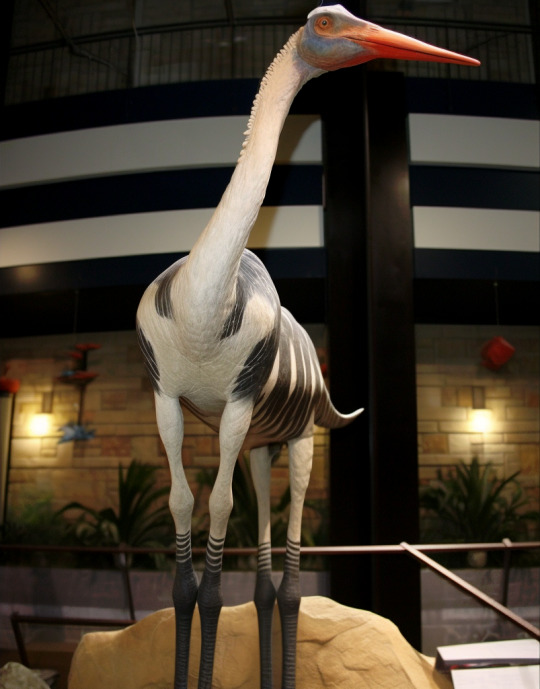
Quetzalokapi model, life size. Vinyl figures and plush toys available in the gift shop.
Midjourney 5.2
#deceptive ai#quetzalcoatlus#okapi#azhdarchid x giraffid hybrid#pterosaur x artiodactyl hybrid#extrasolar and alt-timeline natural history museums
16 notes
·
View notes
Photo
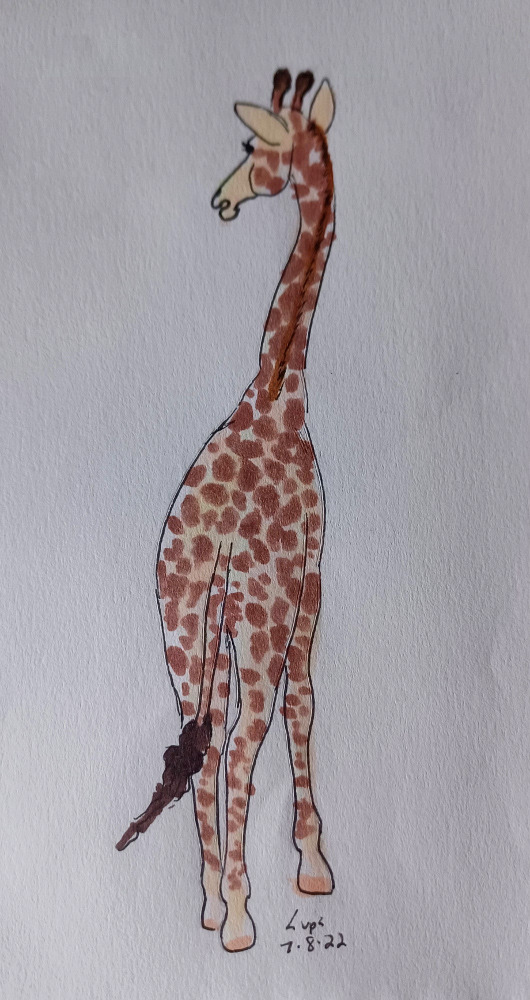
Okay, so I am teaching today which means this poor giraffe for today's Zooly prompt got sketched late last night after hours of driving. Definitely not my best work, but I still find it endearing!
Ink pen and Copic markers.
#Zooly#Zooly art challenge#giraffe#giraffid#ungulate#megafauna#African megafauna#wildlife#animals#nature#traditional art#Copics#ilustration
20 notes
·
View notes
Note
The way you phrased things suggests that other species can and do become gods outside of the three "ponies". Jokes about Hubble the space giraffe aside, I was wondering as soon as you mentioned it: was Baobab once a giraffe, themself? Or were they a pony or some other equine, since the ponies at least also have really long necks once ascending into godhood, and Baobab themself is implied to be much, much older, and hence, larger, than the other gods?
Are they something that perhaps does not exist on the planet any longer? Would a quagga have any reason to go extinct in this world? Other giraffids? Perhaps an antelope? Maybe even an early equine ancestor, whatever came before the "ponies" and their relatives, from whom most (if not all) descend? idk man thinking about it is just kind of Interesting
Boabab was, as best as we can figure, a giraffe, and they are indeed much larger than Celestia. but they are also so old and beyond mortals, that it is much closer to think of Boabab as a tree, or a forest, or a continent, than a person.
"it" is somewhat more appropriate than "they" at this point in time, due to the abstract nature of Boabab's mind, and the complete lack of movement.
Boabab, The Boabab, The Tree/Trees, and Life are all appropriate names for the entity. No connection at all to swamp fever, a disease much younger than when Boabab's legs settled into the earth and became one with the land.
In equestria, there are many sentient creatures besides ponies, but they make up a minority due to pony colonialism and in some cases, settler genocide. Mane-ifest Destiny is a toxic concept still taught to most Equestrian foals today. Buffalo, cows, kirin, and donkeys exist, but in smaller numbers than ponies.
On the Africa-like continent, "people" consist of many species. Zebras, giraffes, antelope, water buffalo, wildebeasts, elephants, etc. Zebras are not the most populous group, and don't think of themselves as better than the other species, but often find Equestrian diplomats assume they are the rulers. Touring ponies will often ignore their giraffe tour guide to talk to an unqualified zebra citizen passing by. It can be irritating and humiliating. But that's what you get when casual pony supremacy is the norm.
There are other countries where the main sentient race are dragons, griffins, seaponies, hippogriffs, yaks, zebus, camels, and more.
176 notes
·
View notes
Text
Miosurnia vs Primoptynx


Factfiles:
Miosurnia diurna

Artwork by @otussketching, written by @zygodactylus
Name Meaning: Diurnal Hawk-Owl from the Miocene
Time: 7.25 to 11.1 million years old (Tortonian stage of the Miocene epoch, Neogene period)
Location: Liushu Formation, Gansu Province, China
Miosurnia was a small owl, weighing around 318 grams and having a similar overall size to its living relatives, the modern hawk-owls. And, like its living relatives, Miosurnia was diurnal (based on its eye shape) - a rarity in owls, mainly seen in Hawk-Owls and putative early members of the group. As such, this small clade of diurnal owls has a longer and more extensive range than previously thought. If so, it may have eaten a variety of small diurnal mammals, similar to small kestrels in many habitats today. This allowed it to live alongside a wide variety of other avian predators, including many Old World Vultures and falcons. Like other diurnal owls, Miosurnia lived in a large open habitat, and this was one right after the great grassland explosion of the Miocene. As the polar ice sheets grew, these large open habitats expanded across the planet, greatly affecting many ecologies. In addition to other birds of prey, Miosurnia shared its habitat with Panraogallus, ostriches, sandgrouse, Ergilornithids, and many mammals such as Cahlicotheris, Gomphotheres, horses, giraffids, and buff hyenas.
Primoptynx poliotauros

Artwork by @otussketching, written by @zygodactylus
Name Meaning: First Owl from the Graybullian
Time: 56 million years ago (Thanetian stage of the Paleocene epoch, Paleogene period)
Location: McCullough Peaks, Willwood Formation, Wyoming
Primoptynx is one of many early owl fossils, but it is unique - in that it’s currently the oldest known owl, appearing during the Paleocene-Eocene Thermal Maximum, soon after the end-Cretaceous. This owl was weird in a variety of ways, lacking many of the later adaptations that make owls unique among birds of prey. The weirdest thing, however, isn’t something it’s missing - its the unique morphology of the foot, where the first and second toes are much larger than expected, much like the feet of diurnal birds of prey (rather than those of owls). Primoptynx was also huge, bigger than other early owls known from the region such as Eostrix. While smaller members of the group at the time were eating small vertebrates, Primoptynx seems to have been adapted for eating much larger prey, such as mid sized vertebrates like those preyed on by Harpy Eagles and other larger birds of prey today. This not only shows that owls tried on a lot of ecological “hats” prior to settling into their modern niches, but also that large birds of prey were fixtures in ecosystems very early on in the Cenozoic. Since early fossils of diurnal birds of prey are comparatively rare, this fills in a major ecosystem gap for the Willwood and beyond. Diurnal owls, like Primoptynx, probably then went extinct due to the radiation of modern diurnal birds of prey (hawks, eagles, and falcons). In the Willwood, Primoptynx was surrounded by many other birds as well as mammals - such as weird stem-ducks and stem-chickens, Lithornithids, Gastornis, Sandcoleids, and a variety of early mammals, all of which would probably have made good prey items for Primoptynx.
DMM Round One Masterpost
#dmm#dinosaur march madness#dmm round one#dmm rising stars#palaeoblr#dinosaurs#paleontology#polls#bracket#march madness#miosurnia#primoptynx
104 notes
·
View notes
Text
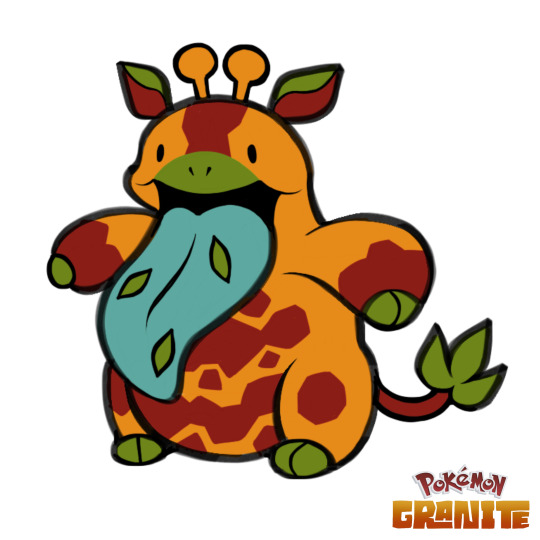

Reachitung
grass
Giraffid Pokémon
Despite resembling lickitung, this pokémon is a cousin to girafarig. its tounge is especially sticky, in order to pluck leaves from trees.


Reachireachy
grass
Giraffid Pokémon
Its tongue and neck have grown even longer to reach leaves. Sometimes, they will blend in with the foliage of the forest, and seemingly disappear amongst the trees.
17 notes
·
View notes
Note
thoughts on Farigarif? honestly I was like "this is nice and all but why now" and then I learned it's based on a four-horned giraffe fossil that was found in Spain and went "okay that's actually clever"

(You guys know the drill; specialty review today for the new trailer, then back to the usual first-come-first-serve order after this.)

I'm really glad Girafarig finally got an evo, as they always felt like they'd be a great pick for one—both because there's a ton of potential there and because they were a single-stager with no real gimmick outside of a cool theme. I love it when forgotten Pokemon finally get some attention, and it's even better in a case like this where the design is good as well.
The meat of the design is obviously the way the tail is handled, with it merging with the head to form a "hoodie" of sorts. Personally, I love this; it's fun, it serves a biological purpose (both protecting them from harm and confusing predators), and it looks slightly ominous when closed. It's also weird as hell, keeping the same strangeness as Girafarig and expanding upon it—which is how I like my Pokemon.

At first, I was confused by the four horns; but like Anon said, it's based off of decennatherium, an extinct animal in the giraffid family that had four horns and lived exclusively in Spain. I will say, however, that while I like the reference, I think the horns could've stood to be smaller; they're so huge like this that they distract greatly from the actual head.
Head area aside, I also appreciate the amount of changes made to the body. First, the longer neck; this was an obvious choice, both to make it more giraffe-like and make it look "older" (the only reason Girafarig had such a short neck in the first place was sprite limitations).
I also really like how the tail's black color is brought onto the neck, effectively inverting the original yellow -> black pattern. The way it runs down the back is reminiscent of a giraffe mane as well, which is neat:
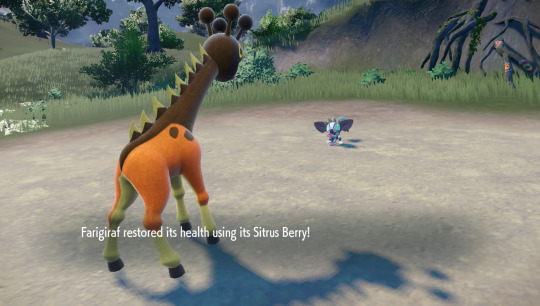
The deeper orange color is also quite nice, and the cream accents give the legs an interesting shape. Likewise, the placement of the spots feels very natural while still looking different.
My only nitpick (outside of the aforementioned horn size) is that the brown running up into the back spines don't accomplish anything and they probably would've looked better just being plain cream. Also, the face "freckles", while cute, are cluttering that area a bit and probably should've been left off. Everything else, however, looks solid.
So overall, a really good evo for a Pokemon that needed it that retains the strangeness of the original design while expanding upon it both visually and thematically. We love to see it!
#farigiraf#girafarig#pokemon#pokemon scarlet and violet#pokemon reviews#you know the irony is that a while back I planned to do my take on a girafarig evo based on the beta sprites#and it also had an elongated neck and inversed colors
165 notes
·
View notes
Text
Spectember Day Two: Foster’s Rule
The diversity of organisms once native to Somali, now isolated on the future continent of Somulunda.
Somulunda Dwarf Elephant: similar to most dwarf elephants. They live in social communities eating grass and bushes.
Ramming Giraffe: about the size of the okapi, these giraffids have forgone browsing in favor of using their necks and horns in combat.
Swamp Rhinoceros: one of the rarest large herbivores, as their name suggests, they are found in small coastal swamps behaving in a similar manner to the hippopotamus.
Lycanon Pictus Robustus (Robust Painted Wolve): a subspecies of the Painted wolf, these wild canines live and hunt in smaller groups in favor of larger sizes and being more capable in taking larger prey.
Somulunda Dwarf Ostrich: very similar to the Common ostrich, although smaller.
Goliath Aardvark: giant insectivores that break into the colossal Fire-Mite mounds. They are resistant to predation when they are adults but they are often preyed upon by predators when they are juveniles.
Runner Bird: large relatives to the secretary bird being one of the largest predators on Somulunda. They chase prey down to exhaustion and then pin them to the ground to kill them.
Swiping Lizard: primarily bipedal monitor lizards, they are large insectivores using their large claws to break into Fire Mite Nests and also serve as a mean of defense.
Fire-Mites: twelve centimeter long termites that build tall and sharp black nests with colonies that can reach half a trillion in 10 years. They are responsible for a unique biome of pitch black 18 foot towers that choke the landscape.

#speculative biology#speculative ecology#speculative evolution#traditional art#speculative zoology#traditional sketch#paleontology#paleontologist#somalia#spectember#specposium#africa#african wildlife
1 note
·
View note
Text

Giraffes by Louis A. Sargent. From Wild Beasts of the World, Vol. Two. Written by Frank Finn, published in 1909.
Internet Archive
142 notes
·
View notes
Note
What are your favourite fun animal facts
oh oh oh what fun! thanks for the question
the thing is many of these facts may be common knowledge to tumblr animal freaks, but to my friends that once were surprised horses and cows are actually very distant animals evolutionary-wise, they seem cool. Since most of us are from the same faculty - soil science, we are more proficient in chem and minerology then bio, im just a freak
Camels are surprisingly scary animals, they have formidable fangs able to easily kill a person if they so choose
Elephants, orcas and hyenas have matriarchies, hyenas have especially gnarly ones
talking about cetaceans, i only recently found out that they and ungulates are now in one order! - Cetartiodactyla, and their closest terrestrial mammal is the Hippo
also a way to research how cetacean populations interact is a whale mite!! which is so cool, there are many species that are unique to each specie of a whale
Hippos, did you know that they are actually runners and not swimmers? their body is mostly muscle, with makes their dense enough to both not sink and not float up. So instead of swimming they basically run on the bottom.
Okapi is actually not the only close relative of the giraffe - see: pronghorns - they may be more distant then okapi's but giraffids are still their closest relatives
Just, everything about Hoatzins - very curious birds if you dont know about them, their diet is mostly comprised of leaves and green plants! they are able to digest it in their enlarged crops that have bacteria cultures similar to ruminants, which also makes them smell like manure - oops! they are called "stinkbirds" bc of that. Additionally, their chicks have claws on their wings (this isnt an entirely uncommon trait in birds but i still think its cool) also they er beautiful
There are two common groups of pinnipeds - seals and sea lions or other names for them - earless and eared seals. Seals are generally more even tempered then sea lions with a notable exception that is seen quite often in documentaries - leopard seal, preying on penguins
this is a fact for YOU ( and not an animal one) bc we had a whole course of soil bio and algology but oomfs you should look up diatoms they are SUCH pretty little guys i love them, there is so much i could say about them but i will direct you to the Octopus Lady on youtube - they have many good videos on water (mainly saltwater but still) organisms,
but one thing she doesn't talk about that i was sad about is how diatoms reproduce. The thing is (watch the video for context) they are build like a petri dish - out of a larger lid (epitheca) and a smaller base (hypotheca), the thing is, when they divide for asexual reproduction, each half get one lid - and BOTH news cells complete the SMALLER lid,
bc of that when diatoms divide one line of the offsprings gets progressively smaller and smaller and smaller, after that sexual reproduction occours so that the cells can restore their size
and i find that really funny
2 notes
·
View notes
Photo
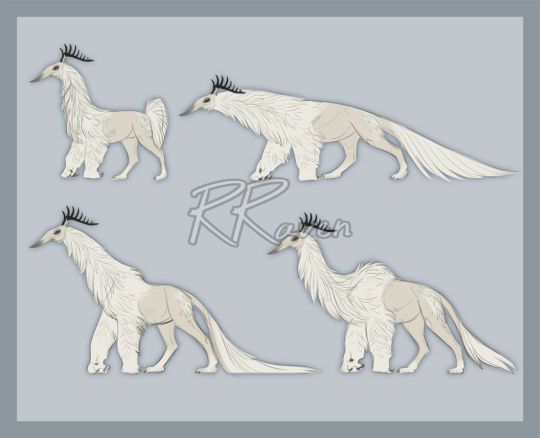

Revamp of an old design.
I’ll probably stick with the original giraffid body type, but I do really like the more horizontal/anteater-y one!
15 notes
·
View notes
Note
bramatherium (brahma's beast)
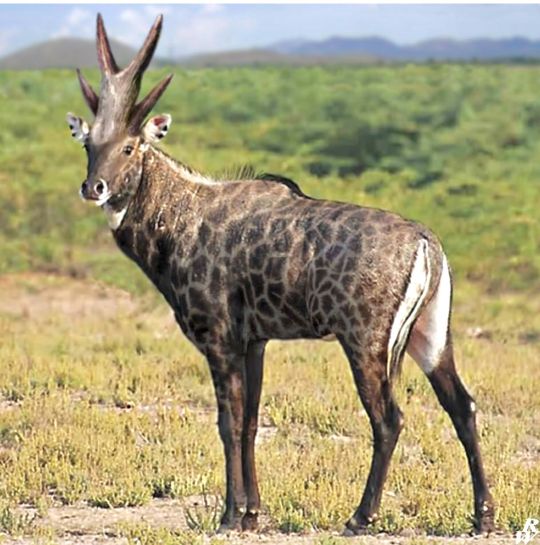
and sivatherium

(shiv's beast) looks a lot like modern okapis
pleistocene era giraffids from india
horns are sooooooo cute
also, sivatherium was the heaviest girrafid, even heavier than modern giraffes, and the largest ruminant ever
Ufffff. So so so beautiful.
You sent this at the best time possible hehe I am in fact reading a book on prehistoric animals
Gosh, that's beautiful. I love them hehe especially the first one uff
6 notes
·
View notes
Note
hiii mutual! tell us a random piece of trivia you like!
Hi mutual! Sivatherium is an extinct giraffid (relative of giraffes, and okapis) that lived during the Miocene in India and Africa that was one of the biggest ruminants to ever exist. 3 meters tall in total height (about as tall as African Elephants) and up to ~1200kg (about the weight of a bison, not including the very large ossicones on males which would have been quite heavy considering they were made of bone).
It probably looked like a jacked up okapi with almost mooselike head ornaments.
#I should really tag asks#moxyinverse#You put me on the spot lol#It took me a bit to think of anything so sorry if this is lame n_n7
2 notes
·
View notes
Text

Northern Giraffe in Murchison Falls National Park, Pakwach, Uganda
Sam Balye
Habitat: East Africa
Conservation status: Vulnerable (Population decreasing)
Family: Giraffids
Length: 14 ft. (Adult)
Lower classifications: Nubian giraffe, West African giraffe, Thornicroft's giraffe, Kordofan giraffe
Scientific name: Giraffa camelopardalis
Mass: 1,800 – 4,300 lbs (Male, Adult), 1,200 – 2,600 lbs (Female, Adult)
Speed: 35 miles an hour
Life Cycle: Giraffes can live as long as 25 years.
The northern giraffe, also known as three-horned giraffe, is the type species of giraffe, G. camelopardalis, and is native to North Africa, although alternative taxonomic hypotheses have proposed the northern giraffe as a separate species.
Northern giraffes live in savannahs, shrublands, and woodlands. After numerous local extinctions, Northern giraffes are the least numerous giraffe species, and the most endangered.
Females give birth throughout the year and usually reach sexual maturity between the ages of five and seven years. Males reach sexual maturity between seven and eight years of age and travel extensively to detect and investigate females receptive to mating.
The Northern Giraffe feeds on shoots, grains, nuts, leaves, flowers, and fruits. They also eat soil to obtain minerals.
#Murchison Falls National Park#Pakwach#Uganda#Africa#National Park#Northern Giraffe#Giraffe#Wildlife#UgandaWildlife#Giraffa camelopardalis#Vulnerable#Population Decreasing
0 notes
Text
Asteriornis vs Panraogallus
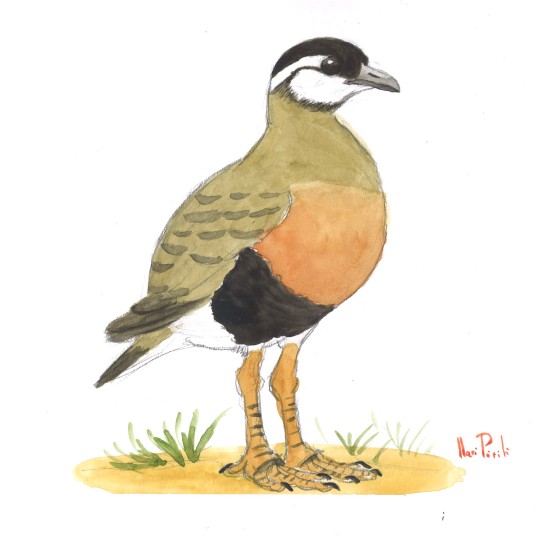

Factfiles:
Asteriornis maastrichtensis

Artwork by @otussketching, written by @zygodactylus
Name Meaning: Asteria’s Maastrichtian Bird
Time: 66.8 million years ago (Maastrichtian stage of the Late Cretaceous_
Location: Maastricht Formation, Eben-Emael, Belgium
Say hello to the Wonderchicken! While we know that modern dinosaurs - birds - had to have evolved in the Mesozoic, and diversified somewhat during it, actual fossil representatives of Mesozoic modern birds are quite rare, with only a few duck-related taxa (Vegavis and Teviornis) known. Asteriornis finally adds a stem-chicken to that group, which we knew had to have been around since we had stem-ducks! (They diverged at the same time, so the presence of stem-ducks requires the presence of stem-chickens). A small, long-legged bird, Asteriornis had a lot of characteristics similar to both chickens and ducks, indicating it may have evolved right after that initial divergence. It had a slightly down-curved beak without specializations, allowing it to have a generalist diet. It had wings similar to living ground birds, and that combined with its long legs indicates a terrestrial lifestyle. Living along the coast, Asteriornis would have eaten whatever it could forage for, possibly wading into the water or trekking through high vegetation when necessary. It lived near the ocean, along the coast, and as such it shared its habitat with many types of invertebrates, including corals and echinoderms and crustaceans, as well as ammonites. Surrounded by grasses, palms, and shrubs, Asteriornis also lived alongside other vertebrates such as a wide variety of sharks, tons of mosasaurs, turtles, elasmosaurs, marsupials, and other dinosaurs such as Orthomerus, Janavis, large theropods, an unknown opposite-bird, and other potential Ornithurans.
Panraogallus hezhengensis

Artwork by @otussketching, written by @zygodactylus
Name Meaning: Coiled Chicken from Hezheng
Time: 7.25 to 11.1 million years old (Tortonian stage of the Miocene epoch, Neogene period)
Location: Liushu Formation, Gansu Province, China
Panraogallus was a weird early chicken that differed from others by one notable feature: a very long neck, much longer than other pheasants. This is only seen in a handful of related birds today. Panraogallus seemed to follow the zigzag pattern present in some grouse rather than a loop like that seen in a cracid or guineafowl. This gave it a low, loud call, distinct from those of other pheasants. It was quite large, around 2.5 kilograms on average. The calls of these species, which would have traveled extremely long distances in its habitat, were probably used in communication - to attract mates, warn of danger, and gather flocks. In the temperate savannah habitat, Panraogallus would have been able to reach each other over large distances, very easily coverable in single days of walking in such an open area. Other birds in the area included the diurnal hawk-owl Miosurnia, kestrels, old world vultures, ostriches, sandgrouse, and the weird Ergilornithids. Mammal neighbors included Gomphotherium, Chilotherium, Chalicotheres, weird horses, bizarre giraffids, and giant hyena mimics.
DMM Round One Masterpost
#dmm#dinosaur march madness#dinosaurs#dmm round one#dmm rising stars#palaeoblr#paleontology#bracket#march madness#polls#asteriornis#panraogallus
94 notes
·
View notes